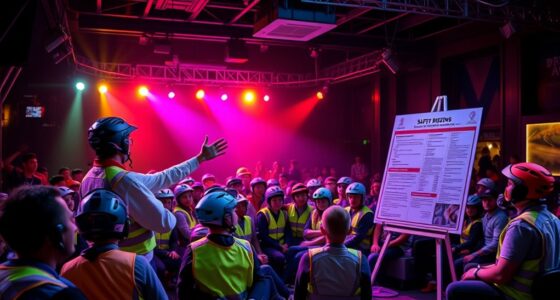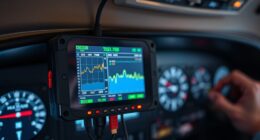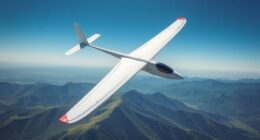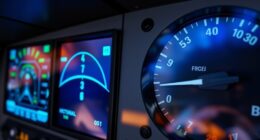To operate a self-launch glider safely, you follow clear procedures focusing on site safety, pre-flight checks, and equipment maintenance. You start by evaluating the launch area for obstacles and hazards, guaranteeing the ground is firm and conditions are suitable. Next, you inspect the glider thoroughly and verify electronic systems. During launch, you stay vigilant about weather and communication, executing procedures with confidence. Continuing with these steps helps you ensure smooth, safe launches every time.
Key Takeaways
- Conduct a thorough site assessment to identify hazards, obstacles, and ensure a firm, level ground surface.
- Perform comprehensive pre-flight inspections of the glider and control systems, confirming safety and proper operation.
- Verify all electronic equipment, including batteries and communication devices, function correctly before launch.
- Confirm weather conditions are suitable and the launch area is clear of bystanders and other aircraft.
- Follow established launch procedures, maintaining communication, safety protocols, and environmental awareness throughout.
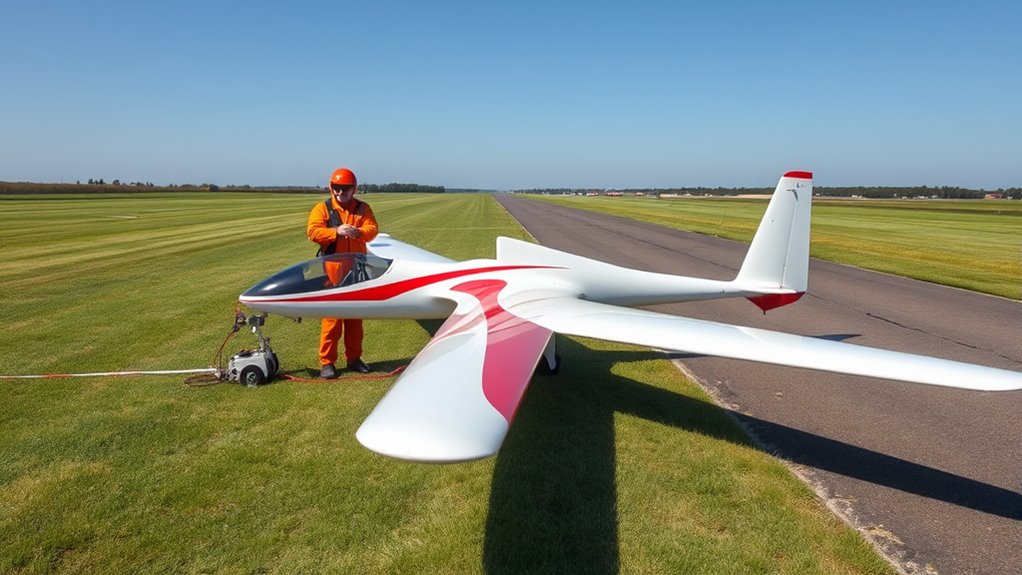
Self-launch gliders allow pilots to take off without external assistance, giving you greater independence and flexibility. This autonomy means you’re responsible for ensuring every step of the launch process is safe and well-executed. Before you even approach the glider, it’s essential to prioritize launch site safety. You need to assess the area thoroughly, checking for any obstacles, overhead power lines, or other hazards that could jeopardize your launch. Confirm that the ground surface is firm and level to prevent any instability during takeoff. Establish clear communication with ground crew if applicable, and ensure that everyone involved knows the plan and safety procedures. Maintaining a safe launch site isn’t just about avoiding accidents; it’s about creating a controlled environment where you can confidently execute your launch without unnecessary risks.
Once you’re on-site, your pre-flight checklist becomes your most critical tool. It’s necessary to systematically verify that all equipment is in proper working order before you attempt to launch. Start with the glider itself, inspecting the wings, fuselage, and control surfaces for any damage or wear. Check that the tow release mechanism functions smoothly and that the air brakes, if equipped, are operational. Don’t forget to review the tail and wheel assembly for integrity. Ensure the harness and safety equipment are secure and in good condition. You should also confirm that all control linkages are correctly connected and free of obstructions. Additionally, understanding the arcade machine technology behind the equipment can help you troubleshoot any electronic systems if needed.
Battery levels on any electronic systems, such as launch assist devices or communication radios, must be sufficient. Review your pre-flight checklist meticulously, ticking off each item as you go. This disciplined approach minimizes the chance of overlooking any critical detail that could impact your safety during launch. Remember, a thorough pre-flight check isn’t just a formality—it’s a safety necessity that prepares you mentally and physically for a successful launch.
During the actual launch process, maintaining focus on launch site safety and adhering to your pre-flight checklist ensures that everything proceeds smoothly. Keep an eye on the weather, especially wind conditions, which can noticeably influence your launch. Confirm that the launch area is clear of bystanders and other aircraft. As you prepare for takeoff, double-check that your equipment is properly configured and that your communication channels are open. Following these procedures consistently will help you execute self-launch glider operations safely, confidently, and efficiently, giving you the freedom to enjoy soaring under your own power.
Frequently Asked Questions
What Are the Legal Requirements for Self-Launch Gliders?
You need to meet specific legal requirements for self-launch gliders, including selecting a suitable launch site that complies with local regulations. Make certain you have the necessary pilot licensing, which varies by country but typically requires proof of competency and adherence to safety standards. Always check with relevant aviation authorities to confirm your compliance, and remember to follow all local rules to operate legally and safely.
How Do Weather Conditions Affect Self-Launch Operations?
Weather conditions greatly impact your self-launch operations. You need to consider wind conditions, as strong or gusty winds can make launching and controlling your glider difficult or unsafe. Thermal activity influences lift, so favorable thermals can aid your flight, while lack of thermals might limit your soaring time. Always check current weather reports, assess wind and thermal patterns, and ensure safety before attempting a launch to prevent accidents.
What Safety Gear Is Recommended During Launch?
Think of your safety gear as your shield in the sky. You should wear protective eyewear to guard against debris and wind, and always guarantee launch site safety by wearing sturdy gloves and a helmet. These items symbolize your readiness and respect for the flight’s power. With this gear, you’re prepared to handle surprises, keeping your focus on the glide ahead while minimizing risks during launch.
How Should Emergencies Be Handled During Launch?
If an emergency occurs during launch, you should immediately activate emergency communication to alert ground personnel and authorities. Keep everyone aware of the situation and follow established launch area safety protocols. Pause the launch if necessary, ensure all team members are clear of hazards, and coordinate with emergency responders. Staying calm, communicating clearly, and prioritizing safety will help manage the situation effectively and prevent further incidents.
Are There Specific Maintenance Checks Before Launching?
Before launching, you should perform a thorough pre-flight inspection, checking the glider’s structure, control surfaces, and propulsion system for any damage or wear. Guarantee the launch area is clear and safe, with no obstacles or people nearby. Confirm all safety protocols are in place, and communicate with your team. These steps help prevent accidents and ensure a smooth, safe launch every time.
Conclusion
By following these procedures, you guarantee safety, efficiency, and confidence with every flight. You prepare thoroughly, execute precisely, and review diligently. You respect the glider, the environment, and yourself. You embrace responsibility, prioritize safety, and pursue excellence. With discipline, awareness, and commitment, you release the true potential of your self-launch glider. Fly with purpose, land with pride, and soar with peace of mind—because these procedures are your foundation for successful, safe, and rewarding flights.





